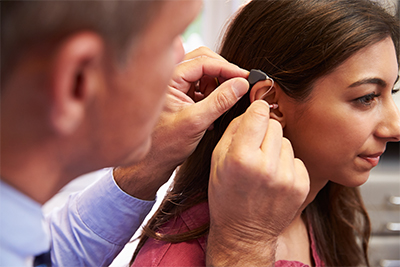USC Speech and Hearing Research Center offers discount on hearing aids for USC employees
March 11, 2016

According to the Hearing Health Foundation, approximately 360 million people worldwide having hearing loss. This is a 44 percent increase over the past 15 years and makes hearing loss the second most prevalent health issue globally. Fifty million of those individuals are Americans, with U.S. numbers doubling from 2000-2015. Hearing loss affects one in every five teens, one in every five adults, and three in every five veterans returning from war. The total number of people with hearing loss is more than those living with Parkinson’s, epilepsy, Alzheimer’s and diabetes combined. Even tinnitus (i.e., ringing or buzzing in the ears) affects an estimated 10 percent of Americans on a regular basis, leading 16 million of them to seek medical attention for this health issue.
“The steady increase in hearing loss is due to three main factors,” says Jason Wigand, Clinical Assistant Professor and Coordinator for the Cochlear Implant Team in the Arnold School’s Department of Communication Sciences and Disorders. “The first is noise-induced hearing loss due to overexposure to excessive noise through work—such as the 30 million U.S. workers who are exposed to hazardous noise levels on the job—or through leisure activities, such as listening to loud music; the second is age-related hearing loss for people ages 65 and over, which is a population that is rapidly expanding; and the third is through the compound effect of the economic impact associated with profound hearing loss—which can add up to $1 million per person in the U.S.”
Cost is just one of the reasons that many of these individuals either do not seek treatment for their hearing loss or do not take advantage of treatment options even if they are available. “Consistently and most reportedly, barriers and challenges to hearing healthcare and hearing aid acceptance are degree of perceived hearing loss—in other words, the individual subjectively believes that his or her hearing is not that bad—stigma, and cost,” says Wigand.
As part of their numerous diagnostic and treatment programs, COMD’s USC Speech and Hearing Research Center helps break down these barriers by providing the community with a comprehensive USC Hearing Aid Program. The program begins with a functional communication assessment, which includes a battery of objective and subjective measures intended to assess residual auditory function beyond what can be determined by listening to just pure tones—a commonly used method for evaluating hearing. One of the Center’s licensed audiologists then puts together a treatment plan with components, such as education and counseling, communication strategies, individualized auditory training, hearing aids, assistive listening devices, and group education and therapy.
“Our approach is to shift the focus from one that is product-oriented—for example, centered around hearing aids—to one that is process-oriented—or centered around enhancing communication,” says Wigand. “Hearing aids are designed to provide access to acoustic information; however, better listening and communication is the ultimate objective, which incorporates not only hearing but also listening skills and communication strategies.”
The program is just one part of the Center’s commitment to serving the local community and individual hearing healthcare needs. This community includes University of South Carolina employees, who now receive a 10 percent discount on hearing aids. “We are proud to be Gamecocks and highly value being a part of the USC team,” says Director Danielle Varnedoe. “We extend this benefit in order to express our appreciation for all the USC family does locally, across the state, and nationally.”



_01.jpg)
_02.jpg)